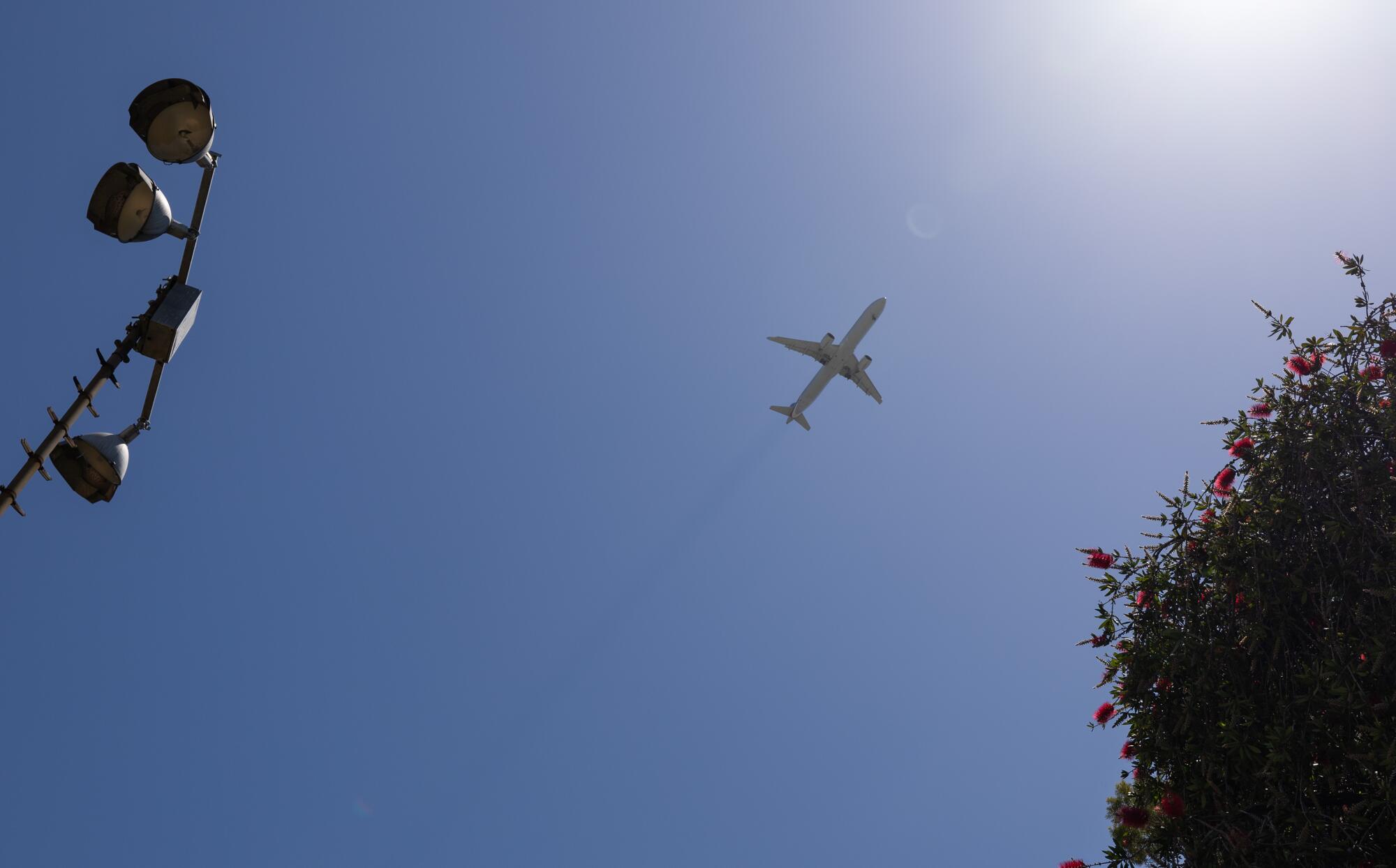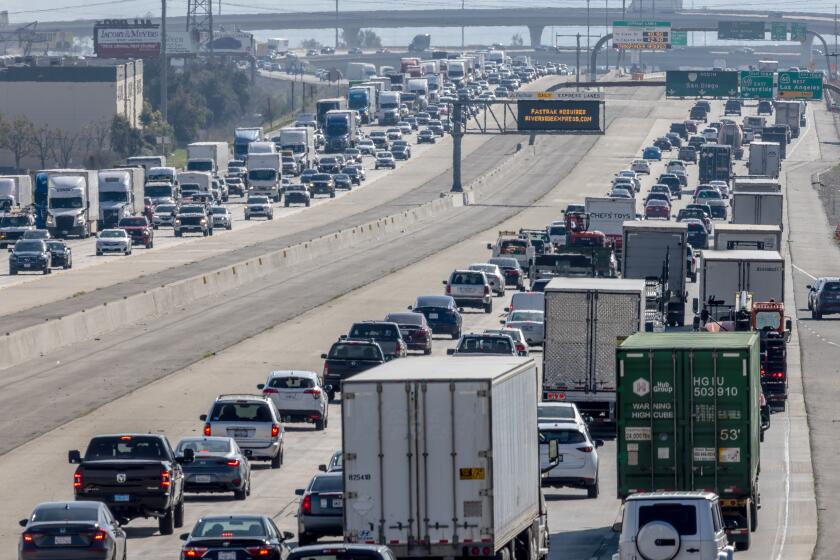
The U.S. Environmental Protection Agency awarded Southern California air regulators nearly $500 million in federal funding to electrify the region’s bustling goods movement, the largest grant the federal agency has ever awarded to combat air pollution.
The EPA announced Monday that it will dole out nearly $4.3 billion in climate grants — funded by the Biden administration’s sweeping Inflation Reduction Act. The largest allocation went to the South Coast Air Quality Management District, the agency tasked with reducing air pollution in the smoggiest air basin in the nation.
The air district had previously applied for federal funding to help deploy more zero-emission vehicles and infrastructure to haul cargo across Greater Los Angeles. Its plan focuses on providing incentives to businesses purchasing battery-electric cargo trucks, delivery vehicles and switcher locomotives (trains that assemble and disassemble lines of rail cars).
Aggressive and impactful reporting on climate change, the environment, health and science.
By transitioning away from diesel-powered engines, the incentives will reduce more than 12 million metric tons of carbon emissions and avoid burning more than 1 billion gallons of fuel from 2025 to 2050, according to estimates. Lawmakers and environmental regulators said the investments also will improve air quality in communities such as City of Commerce, where residents who visit Bandini Park play in the shadow of the 710 Freeway and a sprawling rail yard.
“We shouldn’t have to choose between being a pivotal part of our nation’s economy and having clean air for our children to breathe,” U.S. Sen. Alex Padilla (D-Calif.) said Monday at the park, as semitrucks roared on the highway. “We can do both. We must do both. The $500 million that we’re celebrating today, that’s why it’s such a big deal. It’s going to make an extraordinary impact on decarbonizing the heavy-duty sectors.”
The announcement of the historic funding followed a ceremony during which officials from the EPA and local and state air quality regulators signed a slate of new clean-air commitments — signaling a renewed willingness to cooperate after more than two years of quarreling over Southern California’s noncompliance with federal smog rules.
The EPA has been on the verge of disapproving the air district’s plan to meet the 1997 federal standard for smog, a move that would have led to severe economic sanctions, potentially jeopardizing Los Angeles’ efforts to host the 2028 Olympics. The deadline to meet that standard was June.
To fend off those penalties, air district officials decided to withdraw the region’s smog plan, which they hope will create more time to comply with the federal standard.
For its part, the air district consistently told the EPA that it was impossible to meet the federal smog standard without stricter regulation for planes, trains, interstate trucks and cargo ships — all of which are regulated by the EPA. In its latest proposal, the local air district acknowledged that it needed to reduce smog-forming nitrogen oxides by 108 tons per day, assigning the EPA to slash 67 tons per day from its sources. The federal government refused, declaring states do not have the constitutional authority to give orders to the EPA.
Since 1997, smog-forming emissions have been reduced by around 70%, largely due to the adoption of cleaner car engines and, more recently, electric vehicles, according to the air district. At the same time, aircraft emissions have risen.

A team of Southern California economists recently published a study that found the federal government could drastically reduce aviation emissions by offering to pay airlines to scrap aging airplanes.
In 2009, at the height of the Great Recession, the Obama administration’s “cash for clunkers” program paid 700,000 car owners to scrap older cars with gas-guzzling engines. The initiative cost $3 billion and reduced 9 million metric tons of carbon emissions over 25 years.
Jan Brueckner, an economics professor at UC Irvine and the study’s lead author, said a program to pay airlines to scrap aging airplanes would offer much larger emissions reductions for the value, given that the latest planes produce 20% fewer emissions than older models. He and his colleagues concluded that if the federal government paid the six largest U.S. carriers to scrap 65 older model planes from 2015 to 2019 rather than sell them, it would have cost about $190 million — and reduce roughly 25 million metric tons of carbon emissions.
“Society comes out ahead because the money it’s spending on scrappage pales by comparison to the dollar value of the reduced emissions,” Brueckner said. “An airplane produces lots of emissions compared to a car. That has led to a flight shaming thing that’s going on now where people don’t want to fly because the per-passenger emissions generated is enormous.”
L.A., Orange, Riverside and San Bernardino counties received a failing grade on air quality from the American Lung Assn. Again.
Although California has the authority to regulate vehicle emissions due to its historically poor air quality, the state Air Resources Board is still waiting on the EPA to approve at least nine clean-air rules, which require a federal waiver before they can go into effect. The delay has resulted in delays in banning diesel-powered cargo trucks at California’s ports and rail yards as well as several other regulations.
“We’re fortunate that the [rules] really represent some really innovative and ingenious thinking on the part of the California Air Resources Board,” said Joseph Goffman, deputy assistant administrator at the EPA’s Office of Air and Radiation. “And so we’re taking extra special care to make sure that when we announce our decisions, those decisions are based on a really solid technical and legal foundation.”
Ahead of the tumultuous presidential election, environmental groups have become increasingly concerned about the fate of California’s climate rules, which may face more legal scrutiny and potentially an adversarial second Trump presidency.
Padilla said the newly announced climate funding is “as protected as it can be.” Yet he emphasized the importance of this election for the environment.
“If what we’ve seen from the Republican majority of the House of Representatives this session is any indicator, you can’t take anything for granted,” Padilla said.
Padilla, who grew up in Paicoma in the San Fernando Valley, said he recalls smog so dense that his school would cancel recess or even send students home early.
“The air was that bad,” he said. “And the reality is, that’s still the case for far too many children. But our children deserve better.”
The landmark rule from South Coast AQMD would phase out more than 1 million natural gas-powered appliances, including those that heat swimming pools and hot tubs, and require them to be replaced with electric water heaters.










